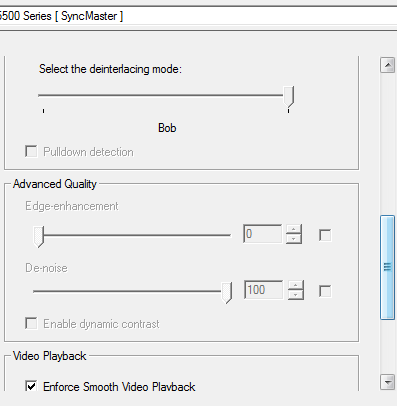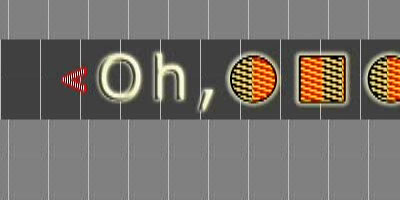AMD’s Radeon HD 5570: Low Profile, Higher Performance
by Ryan Smith on February 9, 2010 12:00 AM EST- Posted in
- GPUs
Still Not the Perfect HTPC Card
After encountering the video decoding limitations of the 5450 in our review of that card, we had been expecting the 5570 to finally fill the role of the perfect HTPC card. Since we had already seen that the 5670 had full video acceleration capabilities under any circumstance, it wouldn’t be much of a stretch for the 5570 to deliver a repeat performance.
Unfortunately that hasn’t come to pass, in fact if anything its proven the 5450 isn’t quite as good of an HTPC card as we first thought.
But before we get ahead of ourselves, let’s start with what’s been a wrench in our plans the entire time: the Enforce Smooth Video Playback option in AMD’s drivers. ESVP is an option in AMD’s drivers that does exactly what it says on the box: it ensures that any videos playing through AMD’s UVD2 decoder play back smoothly. After talking to AMD we’ve come to understand that this is a quality of service mechanism, with there apparently being a couple of different factors involved. The biggest factor as far as the video card is concerned is that when ESVP is enabled, it allows the drives to disable any post-processing features they believe might impact the playback performance of the card.

The AVIVO control panel on the Radeon HD 5570
We’re still going back and forth with AMD trying to get the full details on how ESVP works, but from what we understand thus far and what we’re seeing in the Catalyst Control Center, it looks like AMD is hardcoding their drivers to disable certain post-processing features when ESVP is enabled, depending on the hardware being used. In the case of the 5570, virtually all post-processing features are disabled when ESVP is enabled, with the only remaining options being to select between Bob and Weave deinterlacing.
This actually made us reexamine our 5450, since it didn’t disable so many features when ESVP is enabled. As it turns out that’s a bug in the current version of the drivers for the 5450, and in spite of what the Catalyst Control Center is showing, the 5450 cannot use any additional post-processing features beyond what the 5570 can use, meaning that Edge Enhancement and De-Noise don’t actually work on the 5450 when ESVP is enabled.
As a result, the 5570 does no better on the Cheese Slices video test than the 5450. With ESVP enabled, it can’t do Vector Adaptive Deinterlacing to correct jagged lines on things such as sports fields. It’s still a small issue, but it stands in the way of HTPC perfection.

Cheese Slices:
Radeon 5670 Deinterlacing

Cheese Slices:
Radeon 5570 Deinterlacing
Ultimately the 5450 and 5570 are both limited-functionality cards for HTPC use, giving users the choice between video playback QoS and post-processing. In our testing we didn’t notice any obvious playback issues with the 5450 or 5570 when we had ESVP disabled, but we’ve seen enough forum posts of this feature magically fixing poor video playback performance that we’re not confident enough to recommend disabling this feature. It’s something we think should be left enabled, at least for the time being.
This makes the 5670 the most-perfect HTPC card, as we’ve found it to be able to offer all of AMD’s post-processing features with ESVP enabled, and of course it offers audio bitstreaming like the rest of the 5000 series. The downside to this is that the 5670 is $99, it isn’t low-profile, and at 70W TDP it’s not a particularly cool card. It’s certainly more than workable as an HTPC card, but until someone can get a 5670 out there that’s passively cooled, it’s not the ideal HTPC card that enthusiasts have been looking for.
We’ll also quickly add to this that this all depends on AMD’s drivers, rather than the hardware. Certainly AMD can tweak things if they determine that the 5570 has enough power to do more post-processing, but obviously there’s no guarantee that will happen.










36 Comments
View All Comments
bombacan - Monday, April 5, 2010 - link
when compared to 4670, there is no improvement on neither performance nor power consumption.besides its more expensive and doesn't have a fanless version atm.avhenrik - Saturday, May 15, 2010 - link
I am not a specialist, but check out how rage3d gets smooth deinterlacing with a simpler card (HD 5550) here: http://www.rage3d.com/reviews/video/sapphire_hd555...They combine adaptive vector deinterlacing with other post processing, giving nice results. Have you tried that on the 5570?
hybrid2d4x4 - Thursday, August 26, 2010 - link
It's probably too late to ask this as this article/thread probably never gets checked anymore, but what PSU was used in the review?I'm assuming that it's the standard 750W or higher rated unit that's used for most VGA reviews... but wanted to know how much savings there is to be had by using a low-rated, high-efficiency PSU more suited to a low-power HTPC build.
nfarnham2001 - Monday, December 27, 2010 - link
Okay, I have an HP a6203w desktop with a Bestec 250w PSU. I am looking for an average cheap replacement to the very crappy nvidia 6150se nforce 430 graphics. I am basing my choice off of the fact that video cards without power connectors use the 75 watts of the PCI slot, and since my full system is stock besides 2 more gigs of ram, I figured it could hold it. Professional opinion?dendy - Thursday, July 28, 2011 - link
I was working on the study of the Radeon HD 5570 and NVIDIA GeForce GT 445M for <a href="http://www.bestdealscomputers.net">my blog</a> .... and look for performance comparisons between the two. Is there someone can help?dendy - Thursday, July 28, 2011 - link
http://www.bestdealscomputers.net ... that is my blog.